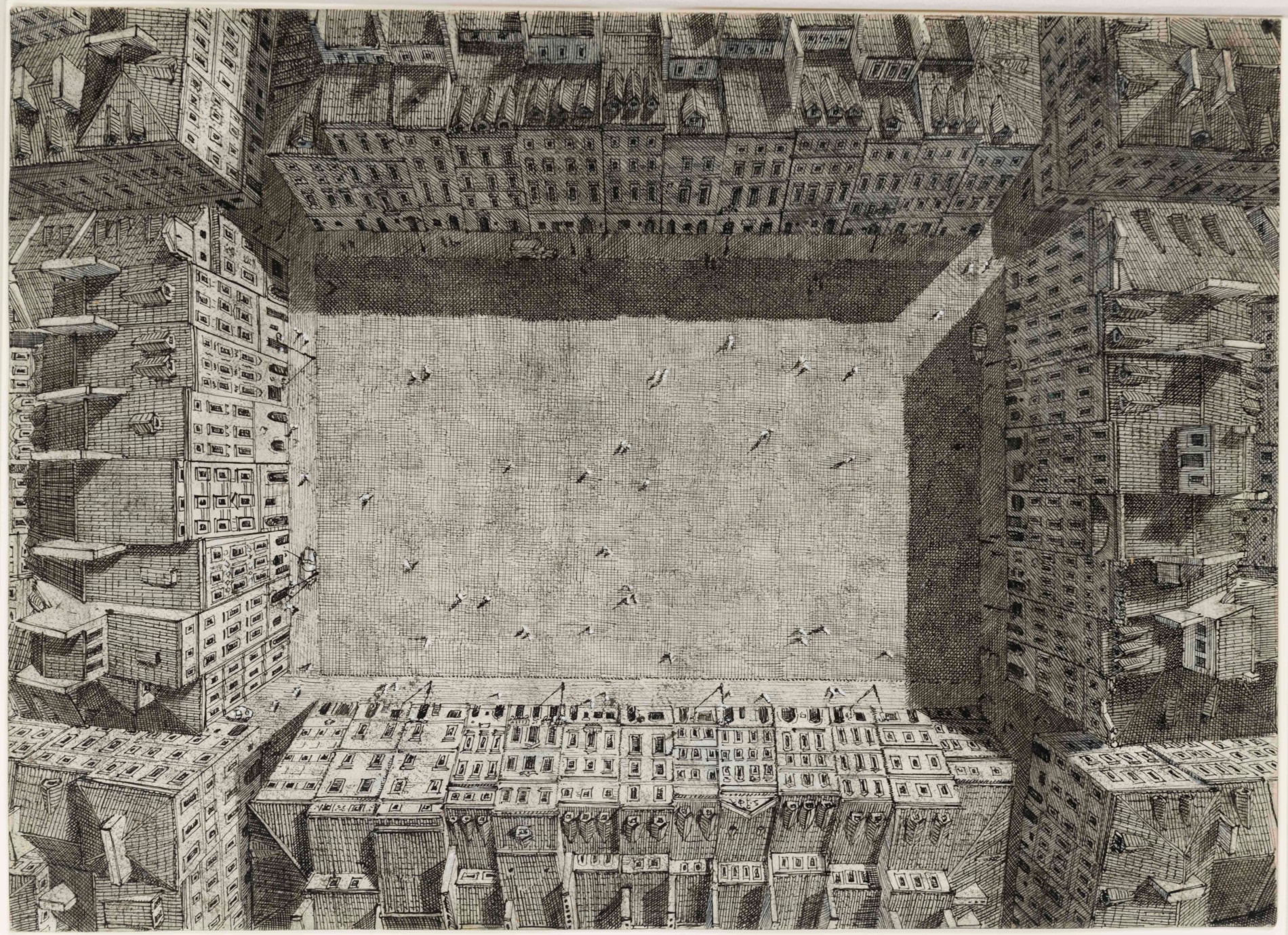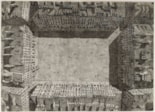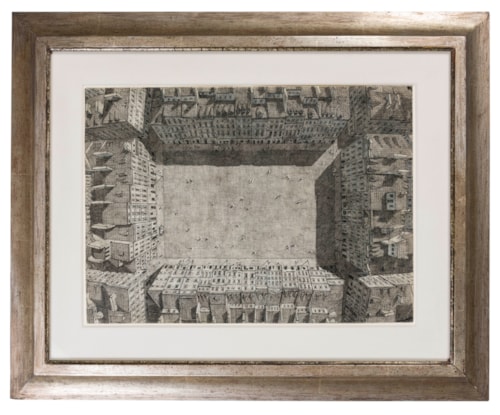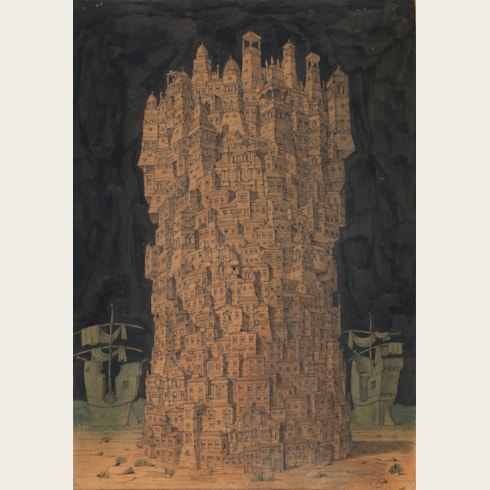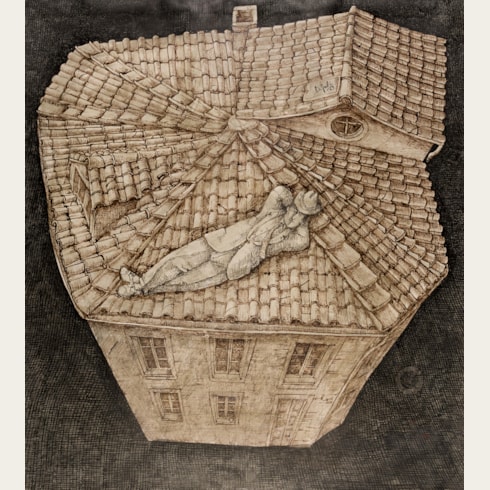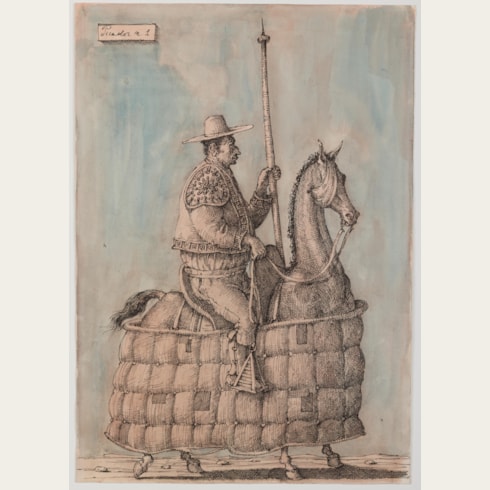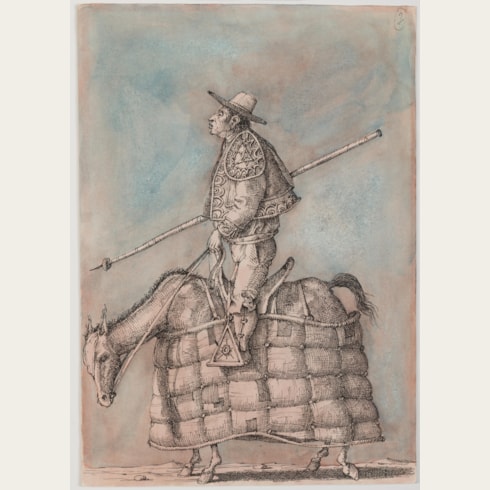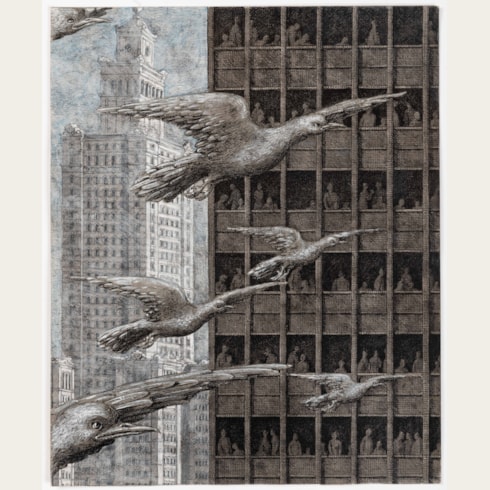Domenico GNOLI
(Rome 1933 - New York 1970)
Old Town Market Place, Warsaw
Sold
Pen and black (Indian) ink.
Inscribed (by the artist?) 'Starego Miastra square in / the old city, rebuilded identical / to what it used to be' on the verso.
Further inscribed Gnoli – Warsaw on the verso.
326 x 452 mm. (12 7/8 x 17 3/4 in.)
Inscribed (by the artist?) 'Starego Miastra square in / the old city, rebuilded identical / to what it used to be' on the verso.
Further inscribed Gnoli – Warsaw on the verso.
326 x 452 mm. (12 7/8 x 17 3/4 in.)
In February 1968 Domenico Gnoli and his wife Yannick Vu travelled to several countries in Eastern Europe, visiting Prague, Warsaw, Moscow and Leningrad, on a commission to produce drawings for Holiday magazine. Warsaw was not actually meant to be on the itinerary, as the artist noted in a letter to Ted Riley: ‘So here we are en route…Very excited indeed and ready for action…I know I was not supposed to go to Warsaw and Leningrad but I find it so silly given the fact that W. is on our route and the other only one and half hours from Moscow ($18 the air fare) that I just decided to go. If Holiday is not interested I’ll pay for it myself.’ Gnoli and Vu spent two days in Warsaw, staying at the Hotel Europejski, and during their walks around the reconstructed postwar city the artist was particularly impressed by how the buildings of the old city had been carefully reconstructed following the destruction of the Second World War.
As the artist noted, in a sort of travel diary written in early March, soon after his return to Rome: ‘The street[s] of Warsaw unbelievably white, swept by the wind, almost without traffic. The squares are as vast as airfields with the snow piled in great drifts along the sides, almost nobody around. Under these squares lie the remains of what had been densely populated areas of the city, also the memory of one million dead...walking further towards the old market and then through what used to be the ghetto and the ancient quarters, thousand[s] of squares, of churches, carefully rebuilt, of sculptures and ornaments dug from under the ruins and replaced where they were, the old colors remembered and now bright again, little by little we begin to understand that this incredible restoration of the past is even more significant than the monuments to the glory of those who perished. The whole city has been rebuilt stone by stone, house by house. Whenever something could be utilized it has been returned to its former place and the wounds from the blows received cured one by one; with patience and infinite labor. But more moving than the labor is the evident, meticulous effort of memory through which everything has been rebuilt. It is impossible to think that more than a few plans of the old buildings were still available: no, these houses have been rebuilt only through the memory of those who survived that remembered miraculously every detail, every shape, every shade of color. More than the tears, memory pays an homage to the past; a city amorously able to retain the image of itself…We’ve been walking for hours and we feel as if we’ve been visiting a double city, that is, a city that is the image of itself besides being itself. Like an echo that twenty years later returns to be the voice that once provoked it.’
The present sheet was one of five drawings of Warsaw by Gnoli used to illustrate an article by Edith Templeton entitled ‘Warsaw and Peace’, published in Holiday magazine in September 1968. This overhead view of the Old Town Market Place in Warsaw (‘Rynek Starego Miasta’ in Polish) was used as a double-page spread illustration in the magazine, accompanied by the caption: ‘The Old Town Market, one of the finest squares in Europe, has been rebuilt from the ground up since World War II, when 85 percent of the buildings in Warsaw were destroyed.’ In the words of one of Gnoli’s fellow artists and admirers, the English illustrator Paul Hogarth, ‘Gnoli’s imaginative reportage of Warsaw for Holiday remains one of the more remarkable examples of contemporary topographical reporting.’
The first owner of this drawing was the magazine editor and art director Frank Zachary (1914-2015), who served as both picture editor and art director of Holiday magazine between 1951 and 1964.
A copy of the September 1968 issue of Holiday magazine is sold with the present sheet.
As the artist noted, in a sort of travel diary written in early March, soon after his return to Rome: ‘The street[s] of Warsaw unbelievably white, swept by the wind, almost without traffic. The squares are as vast as airfields with the snow piled in great drifts along the sides, almost nobody around. Under these squares lie the remains of what had been densely populated areas of the city, also the memory of one million dead...walking further towards the old market and then through what used to be the ghetto and the ancient quarters, thousand[s] of squares, of churches, carefully rebuilt, of sculptures and ornaments dug from under the ruins and replaced where they were, the old colors remembered and now bright again, little by little we begin to understand that this incredible restoration of the past is even more significant than the monuments to the glory of those who perished. The whole city has been rebuilt stone by stone, house by house. Whenever something could be utilized it has been returned to its former place and the wounds from the blows received cured one by one; with patience and infinite labor. But more moving than the labor is the evident, meticulous effort of memory through which everything has been rebuilt. It is impossible to think that more than a few plans of the old buildings were still available: no, these houses have been rebuilt only through the memory of those who survived that remembered miraculously every detail, every shape, every shade of color. More than the tears, memory pays an homage to the past; a city amorously able to retain the image of itself…We’ve been walking for hours and we feel as if we’ve been visiting a double city, that is, a city that is the image of itself besides being itself. Like an echo that twenty years later returns to be the voice that once provoked it.’
The present sheet was one of five drawings of Warsaw by Gnoli used to illustrate an article by Edith Templeton entitled ‘Warsaw and Peace’, published in Holiday magazine in September 1968. This overhead view of the Old Town Market Place in Warsaw (‘Rynek Starego Miasta’ in Polish) was used as a double-page spread illustration in the magazine, accompanied by the caption: ‘The Old Town Market, one of the finest squares in Europe, has been rebuilt from the ground up since World War II, when 85 percent of the buildings in Warsaw were destroyed.’ In the words of one of Gnoli’s fellow artists and admirers, the English illustrator Paul Hogarth, ‘Gnoli’s imaginative reportage of Warsaw for Holiday remains one of the more remarkable examples of contemporary topographical reporting.’
The first owner of this drawing was the magazine editor and art director Frank Zachary (1914-2015), who served as both picture editor and art director of Holiday magazine between 1951 and 1964.
A copy of the September 1968 issue of Holiday magazine is sold with the present sheet.
A precocious artist, Domenico Gnoli took private lessons in drawing and etching from the painter and printmaker Carlo Alberto Petrucci in Rome. He exhibited for the first time, aged just seventeen, at the Galleria La Cassapanca in Rome in 1950, and the following year his work was included in the exhibition Art Graphique Italien Contemporain at the Galerie Giroux in Brussels. After briefly studying theatre design at the Accademia di Belle Arti in Rome, Gnoli began working as a scenographer, producing designs for stage sets and costumes for a production of The Merchant of Venice at the Schauspielhaus in Zurich in 1953, while the following year he worked on designs for a staging of As You Like It at the Old Vic Theatre in London that opened in 1955. Despite the makings of a successful career as a scenographer, however, in 1956 Gnoli decided to give up theatrical work and to concentrate on drawing and painting. He lived between London, Paris and Rome before eventually settling in New York in 1956, where his friends included Leonard Bernstein, Henri Cartier-Bresson, Jerome Robbins and Diana Vreeland.
One-man shows of Gnoli’s drawings and prints were held in New York in 1956, London and Rome in 1957, Rome in 1958, New York in 1959, and London in 1960. He also worked as a book illustrator, writing and illustrating Orestes or the Art of Smiling, published in London in 1960, and two years later providing illustrations for the American writer Norman Juster’s Alberic the Wise and Other Journeys. He also received commissions for illustrations for magazines as diverse as Fortune, Life, Sports Illustrated, Holiday, Show, Horizon and several others, and in 1968 was awarded a gold medal by the Society of Illustrators in New York. Gnoli is perhaps best known today for his paintings executed from 1964 onwards; large canvases in which the artist almost obsessively concentrates his attention on isolated details of clothing, hair and objects.
Gnoli continued to have exhibitions of his work in Italy, France, Germany, England and America, where in 1969 his first solo exhibition of paintings was held at the Sidney Janis Gallery in New York. The year before, while that exhibition was being planned, Gnoli wrote to an American friend in New York: ‘I would hate you to think that I am just losing interest with all this, fooling myself with the idea that Janis will make a great painter out of me, and therefore I needn’t worry about drawings anymore. This would be mad, first because even if the show with him will do well it will only be a temporary success since the art scene is moving so fast that what is great today is shit tomorrow, second, I am, regardless of big money and glamour, a born illustrator, and will not renegade myself.’ Gnoli died in New York in April 1970, just over two weeks before his 37th birthday.
Works by Domenico Gnoli are today in the collections of, among others, the Stedelijk Museum in Amsterdam, the Baltimore Museum of Art, the Staatliche Museen in Berlin, the Museum of Fine Arts in Boston, the Musées Royaux des Beaux-Arts de Belgique in Brussels, the Museum Ludwig in Cologne, the Städel in Frankfurt, the Gemeentemuseum in The Hague, the Hamburger Kunsthalle in Hamburg, the Victoria and Albert Museum in London, the Museo Thyssen-Bornemisza in Madrid, the Museum of Modern Art and the Brooklyn Museum in New York, the Kunstnernes Hus in Oslo, the Philadelphia Museum of Art, the Galleria Nazionale d’Arte Moderna e Contemporanea in Rome, the Boijmans-van Beuningen Museum in Rotterdam, the Peggy Guggenheim Collection in Venice and the National Gallery of Art in Washington, D.C.
Provenance
Frank Zachary, East Hampton, New York
Thence by family descent.
Thence by family descent.
Literature
Edith Templeton and Domenico Gnoli, ‘Warsaw and Peace’, Holiday, September 1968, illustrated pp.50-51; Vittorio Sgarbi, ‘Nel mondo fantastico di Domenico Gnoli’, in Vittorio Sgarbi, L’opera grafica di Domenico Gnoli, Milan, 1985, p.23; Annie de Garrou Gnoli, ‘Catalogo ragionato’, in Sgarbi, ibid., p.160 (as location unknown, not illustrated); Carlo Barbatti and Giulia Lotti, ‘1933-70’. A Life in Pictures and Documents’, in Germano Celant et al, Domenico Gnoli, exhibition catalogue, Milan, 2021-2022, p.299, fig.898.

